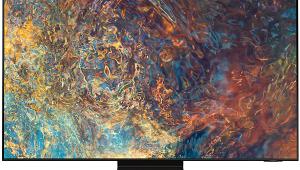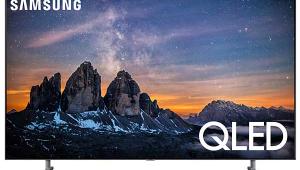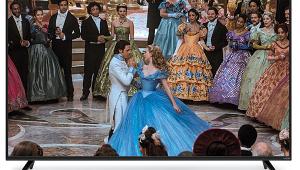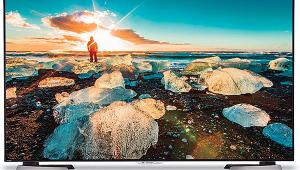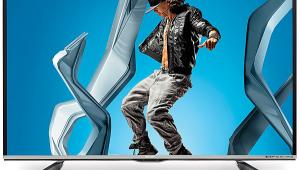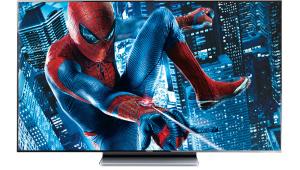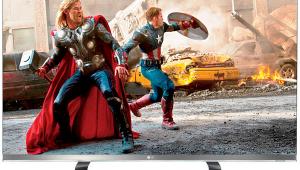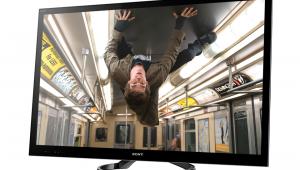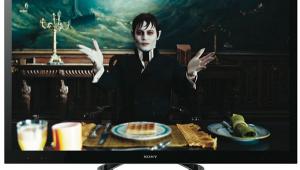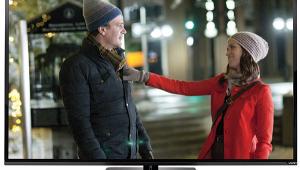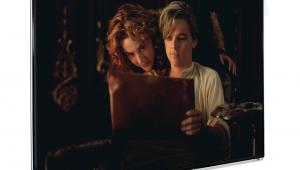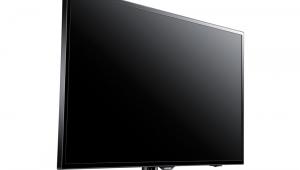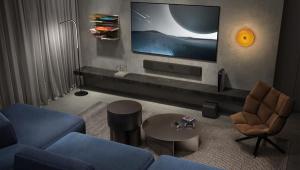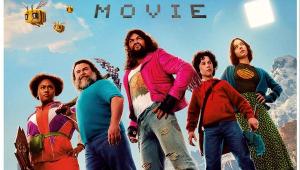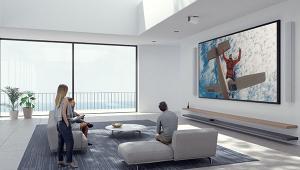Hitachi 32HDL51 LCD HDTV
I decanted Hitachi's 32HDL51 as though it were a vintage wine—delicately, so as not to stir up the sediment. I didn't want to lose a single one of its 1,049,088 pixels. This 32-incher converts all incoming signals to its native resolution, 1366 by 768, but processes video in the ultra-high-res 1080p format.
 A two-tone bezel rims the screen in black, with brighter aluminum stripes at the top and bottom edges. The handsome pedestal is solid aluminum. Hitachi erred, though, in making the black areas so shiny that they picked up reflections from my room's lights. The preprogrammed, backlit remote uses vertical thumbwheels for volume and channel control—I actually enjoyed adjusting the volume.
A two-tone bezel rims the screen in black, with brighter aluminum stripes at the top and bottom edges. The handsome pedestal is solid aluminum. Hitachi erred, though, in making the black areas so shiny that they picked up reflections from my room's lights. The preprogrammed, backlit remote uses vertical thumbwheels for volume and channel control—I actually enjoyed adjusting the volume.
The 32HDL51's connections are located in the Audio Video Control Center, a separate rack-sized component that connects to the display with a two-plug cord. One plug is a proprietary version of DVI that carries both audio and video and works only with the AVCC. The other is an 8-pin mini-DIN that carries infrared and control signals.
Taming the Cable Beast
The back panel includes HDMI and IEEE 1394, as well as a CableCard slot and USB port for a digital camera—none of which I used. My building can't get a satellite or broadcast feed, and I subscribe to a stripped-down basic cable package. However, under an agreement that the major cable operators and DTV makers have signed, all CableCard-compatible products also have a built-in QAM tuner to handle unencrypted digital cable channels, which typically include cable-carried broadcast and other bottom-tier channels, without either a card or a box. This set also handles digital and analog broadcast channels directly through its tuner.
This was the moment I'd been looking forward to ever since that agreement was signed in December, 2002. I plugged my cable feed into the Control Center's Antenna A input (one of two) and started the Auto Channel Scan. Then, with barely contained excitement, I began surfing to see what I had.
My cable operator maps broadcast DTV channels in the 700 range: Channel 13 (WNET, my local PBS affiliate) lives at 713. I pressed that number, but the display told me that the signal was weak or absent. None of the other 700-series DTV channels were present, either, but I could get analog channels.
After I'd surfed through the entire sequence I realized that the set had remapped the DTV channels into a different prefix: 713 became 1-13. And there it was, the most beautiful sight in the world—the cherubic face of Rudy Maxa, host of SmartTravels, along with the telltale "thirteen HD" logo. I hope Rudy won't let this go to his head.
Pix and Patterns
Maxa gave me a great tour of the ruins of Athens, Rome, and Roman outposts in Sicily and the south of France. My jaw hit the floor several times as the camera panned over brilliantly sunlit relics of the ancient world. Buildings were full of pockmarked, weather-beaten, crumbling textures. Statuary in museums had the subtle gradations of near-three-dimensionality.
 I saw a few video artifacts—for instance, some flicker on the vertical detail of the Pantheon's columns—but they were minor and intermittent, and subsequent programs looked smoother. The set's 1080p video processing, essentially a progressive-scan version of the 1080i HDTV format, looked phenomenal.
I saw a few video artifacts—for instance, some flicker on the vertical detail of the Pantheon's columns—but they were minor and intermittent, and subsequent programs looked smoother. The set's 1080p video processing, essentially a progressive-scan version of the 1080i HDTV format, looked phenomenal.
The highlight of watching HDTV through the cable box's component output was Tracks Ahead, a PBS program for train buffs. Views of upper Manhattan's Hellgate Bridge were stirring. Overall, though, the picture looked a bit softer than a direct digital cable feed.
The eye candy looked even better after I adjusted the user controls using the Digital Video Essentials DVD. You can select a Day or Night set of user preferences; I picked the latter because it's always night in my apartment. The contrast ended up on the high side, at 69 out of 100. On the other hand, color dropped to 23. The set's color potential is intense, and it needs a low color level to compensate for some red push.
Subjectively, the color looked fine with real pictures. In fact, the set has two different color profiles for HD and SD and switches to the correct profile depending on which format it auto-detects. According to Hitachi, it also uses a 7.5-IRE black level with 480i signals and 0 IRE with 480p or HD signals.
Strolling Into the Sunset
It was hard to break away from the QAM cornucopia, but I did watch a few DVDs, of which the most memorable was Before Sunset. The 32HDL51 seems to have a greater-than-average resistance to the LCD-lag phenomenon that makes other such sets seem brain-damaged.
My ultimate criterion for great gear is: Can it suspend disbelief and pull me into a story? The Hitachi 32HDL51 performs that emotional sleight of hand like a master. I'd have kept it if I could have gotten away with it.
* Mark Fleischmann is the author of Practical Home Theater, available through www.quietriverpress.com.
Highlights
• A smooth, eye-catching picture in a sleekly designed package
• Integrated broadcast/QAM tuners and CableCard ease setup woes
